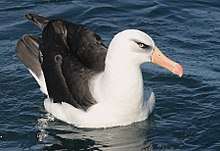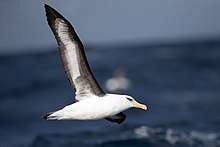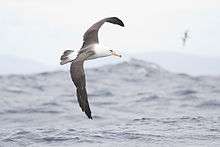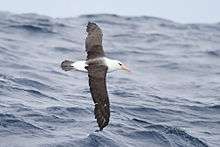Campbell albatross
The Campbell albatross or Campbell mollymawk (Thalassarche impavida) is a medium-sized mollymawk in the albatross family. It breeds only on Campbell Island and the associated islet of Jeanette Marie, a small New Zealand island group in the South Pacific. It is sometimes considered a subspecies of the black-browed albatross. It is a medium-sized black and white albatross with a pale yellow iris.[4]
| Campbell albatross | |
|---|---|
 | |
 | |
| Scientific classification | |
| Kingdom: | Animalia |
| Phylum: | Chordata |
| Class: | Aves |
| Order: | Procellariiformes |
| Family: | Diomedeidae |
| Genus: | Thalassarche |
| Species: | T. impavida |
| Binomial name | |
| Thalassarche impavida | |
| Synonyms | |
| |
Taxonomy
Mollymawks are a type of albatross that belong to family Diomedeidae of the order Procellariiformes, along with shearwaters, fulmars, storm petrels, and diving petrels. They share certain identifying features. First, they have nasal passages that attach to the upper bill called naricorns, although the nostrils on the albatross are on the sides of the bill. The bills of Procellariiformes are also unique in that they are split into between seven and nine horny plates. Finally, they produce a stomach oil made up of wax esters and triglycerides that is stored in the proventriculus. This is used against predators as well as an energy-rich food source for chicks and for the adults during their long flights.[5] They also have a salt gland situated above the nasal passage which helps desalinate their bodies, necessary due to the high amount of ocean water that they imbibe. It excretes a high saline solution from their nose.[6]
In 1998, Robertson and Nunn suggested the species be split off of the black-browed albatross, Thalassarche melanophrys.[7] Over the course of the next few years more experts agreed, starting with BirdLife International in 2000,[4] followed by Brooke in 2004.[8] James Clements did not agree,[9] the ACAP has not agreed yet, and SACC recognizes the need for a proposal.[10]
Description
It weighs 3.21 kg (7.1 lb) and is 88 cm (35 in) long.[4][11][12] The adult is very similar to the black-browed albatross, differing in eye color. It has a white head, neck, rump, and underparts, with a black upperwing, back, and tail. The underwing is white with broad black edging. It has a black triangle around the eye that reaches the bill, which is yellow with an orange tip. They also have a pale yellow iris. The juveniles have a brown-grey bill with a black tip, dark eyes and less black on the underwing. The average life expectancy is given as 28 years, though this is likely due to lack of study as most albatross can live to well beyond 50 years.[4]
Range and habitat


| Location | Population | Date | Trend |
|---|---|---|---|
| Campbell Island & Jeanette Marie, Campbell Islands | 24,600 pairs | 1997 | Increasing 1.8% yr |
| Total | 49,000 | 1997 | Increasing 1.8% per yr |
The Campbell albatross breeds on the northern and western coastline of Campbell Island and the islet Jeanette Marie. When breeding they forage from South Island and the Chatham Rise to the Ross Sea.[13][14] Juveniles and non-breeders will go only through south Australian water, the Tasman Sea, and southwestern Pacific Ocean.[15][16]
Behavior
Feeding
The Cambell albatross feeds on fish, squid, crustacea, carrion, and gelatinous organisms.[17]
Reproduction
Breeding birds like to nest on ledges and steep slopes covered with low grass, tussock, or mud.[8] They start breeding at 10 years[16] and they have a breeding success rate of 66%.[4] Adults return to the breeding colony in early August and begin laying in late September. The single egg is incubated for around 70 days. The chicks fledge after about 130 days after hatching.[8]
Conservation
The IUCN classifies this species as vulnerable due to the limited number of breeding locations.[1] The most recent estimate was in 1997 and counted 24,600 pairs.[18] Between 1992 and 1997 sampled colonies have been increasing at the rate of 1.8%.[18] Adult survival rate is at 94.5%.[4] It has an occurrence range of 31,700,000 km2 (12,200,000 sq mi) and a breeding range of 13 km2 (5.0 sq mi).[4]
The largest threat to this species are fisheries, both longline[15][19][20] and trawlers.[19][21]
The feral sheep that existed on Campbell Island were fully eradicated by 1991, and rats and cats were eradicated by 2001.[22] Finally, studies are ongoing.[20]
Footnotes
- BirdLife International (2012). "Thalassarche impavida". IUCN Red List of Threatened Species. 2012. Retrieved 26 November 2013.CS1 maint: ref=harv (link)
- Brands, S. (2008)
- Mathews, Gregory M. (1912). "Thalassarche melanophris impavida. Australian Black-Browed Mollymawk". The Birds of Australia. 2. London: Witherby. pp. 267–272.
- BirdLife International (2008)
- Double, M. C. (2003)
- Ehrlich, Paul R. (1988)
- Robertson, C. J. R. & Nunn (1998)
- Brooke, M. (2004)
- Clements, J. (2007)
- Remsen Jr., J. V. (2008)
- http://journals.royalsociety.org/content/e18450676360r47p/%5B%5D
- http://birdstage.quinn.com/datazone/species/index.html?action=SpcHTMDetails.asp&sid=30007&m=0%5B%5D
- Waugh, S. M., et al. (1999a)
- BirdLife International (2004)
- Croxall, J. P. and Gales, R. (1998)
- Waugh, S. M., et al. (1999)
- Cherel, Y., et al. (1999)
- Moore, P. J. (2004)
- Heather, B. D. & Robertson, H. A. (1997)
- Taylor, G. A. (2000)
- Baird, S. J. & Smith, M. H. (2007)
- Moore, P. J. (2003)
References
- Baird, S. J.; Smith, M. H. (2007). "Incidental capture of seabirds species in commercial fisheries in New Zealand waters, 2003-2004 and 2004-2005". New Zealand Aquatic Environment and Biodiversity Report (9).
- BirdLife International (2004). Threatened birds of the world 2004 (CD-ROM). Cambridge, U.K.: BirdLife International.
- BirdLife International (2008). "Campbell Albatross - BirdLife Species Factsheet". Data Zone. Retrieved 22 Feb 2009.
- Brands, Sheila (Aug 14, 2008). "Systema Naturae 2000 / Classification - Diomedea (Thalassarche) melanophris -". Project: The Taxonomicon. Retrieved 22 Feb 2009.
- Brooke, M. (2004). "Procellariidae". Albatrosses And Petrels Across The World. Oxford, UK: Oxford University Press. ISBN 0-19-850125-0.
- Cherel, Y.; Waugh, S.; Hanchet, S. (1999). "Albatross predation of juvenile southern blue whiting (Micromesicus australis) on the Campbell Plateau". New Zealand Journal of Marine and Freshwater Research. 33 (3): 437. doi:10.1080/00288330.1999.9516889.
- Clements, James (2007). The Clements Checklist of the Birds of the World (6th ed.). Ithaca, NY: Cornell University Press. ISBN 978-0-8014-4501-9.
- Croxall, J. P.; Gales, R. (1998). "Assessment of the conservation status of albatrosses". In Robertson, G.; Gales, R. (eds.). Albatross biology and conservation. Chipping Norton, Australia: Surrey Beatty & Sons.
- Double, M. C. (2003). "Procellariiformes (Tubenosed Seabirds)". In Hutchins, Michael; Jackson, Jerome A.; Bock, Walter J.; Olendorf, Donna (eds.). Grzimek's Animal Life Encyclopedia. 8 Birds I Tinamous and Ratites to Hoatzins. Joseph E. Trumpey, Chief Scientific Illustrator (2nd ed.). Farmington Hills, MI: Gale Group. pp. 107–111. ISBN 0-7876-5784-0.
- Ehrlich, Paul R.; Dobkin, David, S.; Wheye, Darryl (1988). The Birders Handbook (First ed.). New York, NY: Simon & Schuster. pp. 29–31. ISBN 0-671-65989-8.
- Heather, B. D.; Robertson, H. A. (1997). The field guide to the birds of New Zealand. Oxford, UK: Oxford University Press.
- Moore, P. J. (2003) in litt
- Moore, P. J. (2004). "Abundance and population trends of mollymawks on Campbell Island". Science for Conservation. Wellington, NZ: Department of Conservation (242).
- Remsen Jr., J. V.; et al. (7 Aug 2008). "A classification of the bird species of South America, South American Classification Committee, American Ornithologists' Union". South American Classification Committee. American Ornithologists' Union. Archived from the original on 2009-03-02. Retrieved 22 Feb 2009.
- Robertson, C. J. R.; Nunn, G. B. (1998). "Towards a new taxonomy for albatrosses". In Robertson, G.; Gales, R. (eds.). Albatross biology and conservation. Chipping Norton, Australia: Surrey Beatty & Sons. pp. 13–19.
- Taylor, G. A. (2000). "Action plan for seabird conservation in New Zealand. Wellington: Department of Conservation". Threatened Species Occasional Publication (16).
- Waugh, S. M.; Weimerskirch, H.; Cherel, Y.; Shankar, U.; Prince, P. A.; Sagar, P. M. (1999). "Exploitation of the marine environment by two sympatric albatrosses in the Pacific Southern Ocean". Marine Ecology Progress Series. 177: 243–254. doi:10.3354/meps177243.
- Waugh, S. M.; Weimerskirch, H.; Moore, P. J.; Sagar, P. M. (1999a). "Population dynamics of Black-browed and Grey-headed Albatrosses Diomedea melanophrys and D. chrysostoma at Campbell Island, New Zealand, 1942-96". Ibis. 141 (2): 216–225. doi:10.1111/j.1474-919x.1999.tb07544.x.
External links
- Species factsheet - BirdLife International
